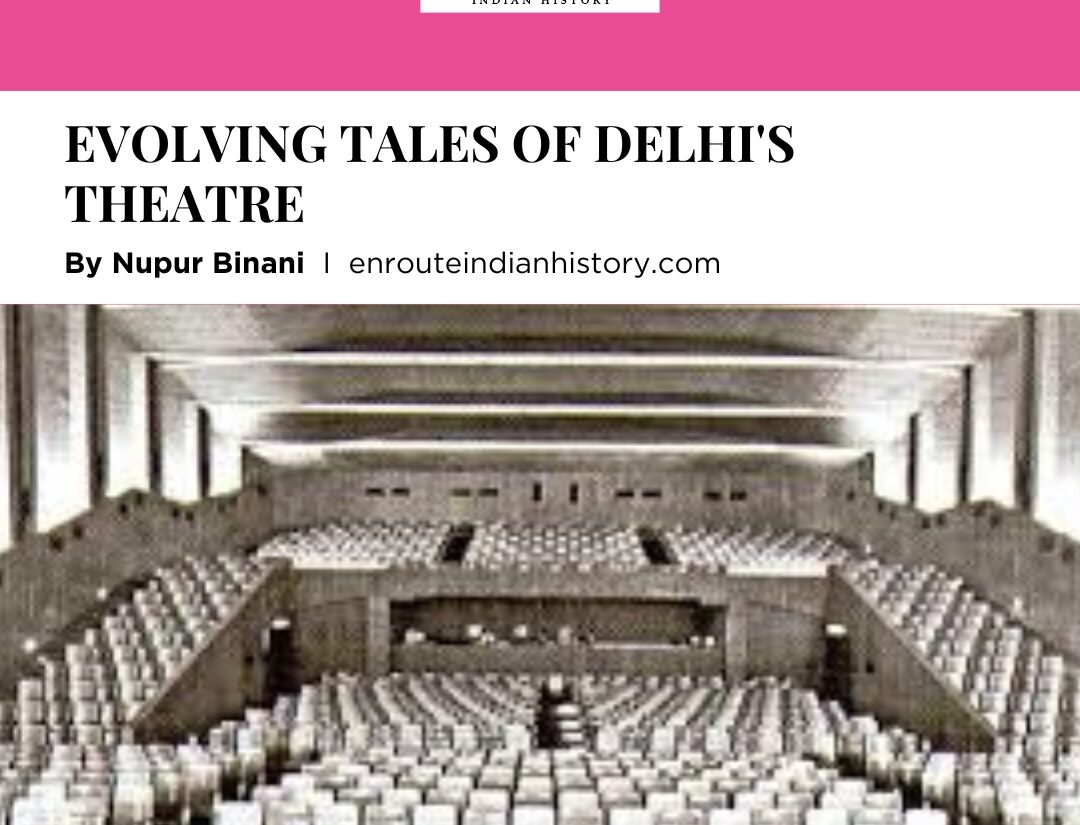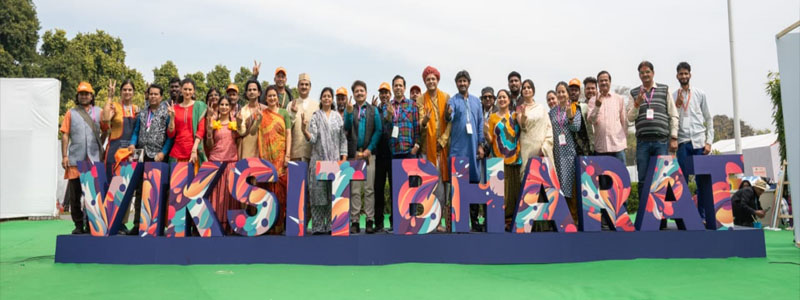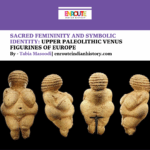
On our own, Theatre can be the place where we come together, reaching with and through stories, to who we are and to who we can be.
-Juliet Stevenson
Theatre
Theatre being an never ending form of art evolves over the passages of time, reflecting the city’s evolution from a historical stronghold to a modern metropolis. Indian Theatre is a blanket woven with rich cultural, traditions and modernity, not just the modern theatre which can be viewed from anywhere but the Indian society embedded threatre in a form of “Art”. From the ancient time, plays evolved from Rituals and traditions in form of storytelling, impersonation, dances- musics to a more structured and performative. It is hard to say how old theatre actually is. Various sources suggest different timelines. The archaeological evidence from Jogimara and Sitabena caves, near Sarguja, Chhattisgarh suggest that they are more than 2300 years old, termed as the oldest amphitheaters of the world. While looking at the literary sources, it suggests a celestial origin of theatre. It also relates theatre with dance. The primary source of Sanskrit theatre is Bharat Muni’s Natya Shastra. Sanskrit theatre took a definite backseat in the medieval period. The frequent interregnum periods due to rise and fall of various Rajput empires and the continuous invasions from North West affected the lives of Indians.Without patronage from kings, it could not survive due to lack of resources. Soon with the advent of bhakti and sufi movement, art forms started reviving. These movements liberalized not only their respective religions but also affected people of other religions as well. The popularity of theatre can be inferred from the fact that not only did the rulers patronize great dramatists; they also composed great works themselves. For example, The great Pushyabhuti king, Harshavardhan of 6th century CE composed three dramas playing a huge role in telling the history.

Delhi, as the capital city of sovereign India, is embedded in concentric circles of international, national and local power, each exerting its
particular demands and stresses on its constituencies. Being the Capital city, it is the center of some major plays, street and stage show framing pages for perfect social and political satire. Delhi’s modern theatre gave world finest actors creating golden pages for India but it is important to understand the origin of drama. One of the earliest and most important , Bharat Muni’s Natya Shastra is the 5th veda because it takes words from Rigveda, music from Samaveda, gestures from Yajurveda and emotion from Atharvaveda describes theatre as, “Natya is the presentation of the essence and state of all the three worlds. There is no knowledge, no craft, no learning, no art, no yoga, no action that is not present in natya.
Dramas are the plays written for performance in theatre are thoroughly embedded in Delhi’s rich cultural thread. Early in 1950 it was possible to talk not quite of the Delhi Stage but of theatre in Delhi. There were a large number of rather formless, abortive amateur theatrical groups that lacked direction more than talent and organization more than finance.

There was the local branch of Theatre Centre; the Delhi Natya Sangh that provided the framework for the collective working of friendly amateur groups. There was the Little Theatre Group that had become the focus of some spirited planning and production, soon unity theatre were formed from the society’s members of University of Delhi to name a few are Shakespeare society of St Stephens, Players of Kirorimal who even had intercollege competitions igniting a sense of theatre in youngsters. The Delhi Arts Society with a strong character of its own that it imparted to the highly-flavored and frequently very vital productions it put on, acted in Punjabi. The Indraprastha Natya Mandal put Vivah Bandhan in 1950 in Hindustani. It was translated from a Marathi original, produced by R. G. Anand became a household word in Delhi theatre. Drama in Hindustani in the meanwhile flourished among a number of groups and the Indian National Theatre at Delhi took the lead in many of these, absorbing talent such as R. G. Anand’s with productions of contemporary interest like Elections and Hum Hindustani, etc. The modern Delhi is known for its famous institution especially National school of drama who gave few of the finest artists like Om puri, Naseeruddin Shah, Piyush Mishra, Anupam Kher, Ratna Pathak, Irrfan Khan and many more to go; not only they set stage for Delhi’s theatre but later set benchmark for Bollywood.

The National School of Drama is one of the foremost theatre training institutions in the world and the only one of its kind in India. It was set up by the Sangeet Natak Akademi as one of its constituent units in 1959. In 1975, it became an independent entity and was registered as an autonomous organization under the Societies Registration Act XXI of 1860, fully financed by the Ministry of Culture, Government of India. Training in the School is highly intensive and is based on a thorough, comprehensive, carefully planned syllabus which covers every aspect of theatre and in which theory is related to practice. As a part of their training, students are required to produce plays which are then performed before the public. The syllabus takes into account the methods of great theatre personalities who have shaped contemporary theatre in all its variety. The systematic study and practical performing experience of Sanskrit drama, modern Indian drama, traditional Indian theatre forms, Asian drama and western dramatic protocols give the students a solid grounding and a wide perspective in the art of theatre. Suresh Awasti, a formed director of National School of Drama shared his experience of 1960s , “We used a variety of spaces-from the school’s small closed Studio Theatre to the open-air Meghdoot Theatre, and also unusual environmental spaces with ramparts, gates, and multilevel platforms at the sites of historical monuments, such as Firozshah Kotala and Purana Qila, Delhi’s Old Fort. This also, perhaps, happened because the school never had a proscenium theatre. Badal Sircar has now been using ordinary halls and public parks for nearly 15 years, manipulating spaces to create a variety of spatial relationships between the actors and spectators. In recent years, a number of other directors have used a variety of open spaces to suit their production designs. They fully realize the importance of space in shaping a performance, and the role the spectators play in such neutral and informal spaces.”

The School has two performing wings – the Repertory Company and Theatre-in-Education Company. The Repertory Company was started in 1964 with four artistes – Shri Ramamurthy, Ms. Meena Williams, Ms. Sudha Shivpuri and Shri Om Shivpuri – with the objective of providing a platform where graduates of the School could perform plays professionally. Over the years it has presented works of various playwrights and directors who have been associated with it and has evolved into one of NSD’s major institutions, working on contemporary and modern plays as well as introducing experimental work on a regular basis. In addition to doing productions, it organizes its own Festival, where past and new productions are introduced and staged each summer. NSD’s Repertory Company also tours and performs extensively in India and abroad. The second performing wing the ‘Theatre-In-Education Company’ (Sanskar Rang Toli) was established in October 16, 1989, and is one of the most important theatre education resource centres in the country. It consists of a group of actor-teachers working with and performing for children. The major focus of the TIE Company is to perform creative, curriculum-based and participatory plays in schools, specially designed and prepared for children of different age groups. The major thrust of the plays is to create an atmosphere that encourages children to raise questions, take decisions and make choices with an awareness of themselves within the larger social context. The TIE Company has done more than 800 performances of 26 plays in Delhi and other parts of the country. The School also has an active Extension Programme, a publication section and a literary forum named Shruti.

Theatre does not simply occur in available space. It creates its own space, and alters what is already there. Performers and spectators separately and also jointly contribute to the transformation of space, creating a variety of spatial configurations during the course of the performance. The character of the performance, the physical setting, and the placing of the spectators in relation to the performance space all have a role to play in shaping and determining theatrical space. The Asian Theatre Institute, organized by the Bharatiya Natya Sangh with expert assistance from Unesco, is in being we know that the long trek towards a Stage that Delhi can call her own, is on and that nothing but our own mistakes of exaggerated and destructive individualism can hold back the promise of that regular, daily theatre that has been the dream of so many hundreds of people who have worked for theatre at Delhi.
Delhi has been a abode of different cultures, regions, traditions where people openly exchange their ideas but this modernized theatre will never fade the charm of the legacy of Delhi’s theatre.
“An Indian who gets a Western education is also part of the Indian reality; an Indian theatre that is influenced by Western theatre especially after such a long history of exchange is part of our Indian experience”.

References-:
- Induja Awasthi.Retrospective of Modern Indian Theatre: New Delhi, 1989. TDR (1988-), Vol. 34, No. 3 (Autumn, 1990), pp. 183-189.
- Mrs. Muriel Wasi.Theatre at Delhi Today. Indian Literature, Vol. 1, No. 2 (Apr.—Sept. 1958), pp. 145-150
- Shayoni Mitra.Contesting Capital A History of Political Theatre in Postcolonial Delhi.
- Lola Chatterji and Lola Chatterjee. The Evolution of Indian Theatre
- Suresh Awasthi.Theatre of Roots, Encounter with Tradition.
- https://nsd.gov.in/delhi/index.php/about-nsd/

















